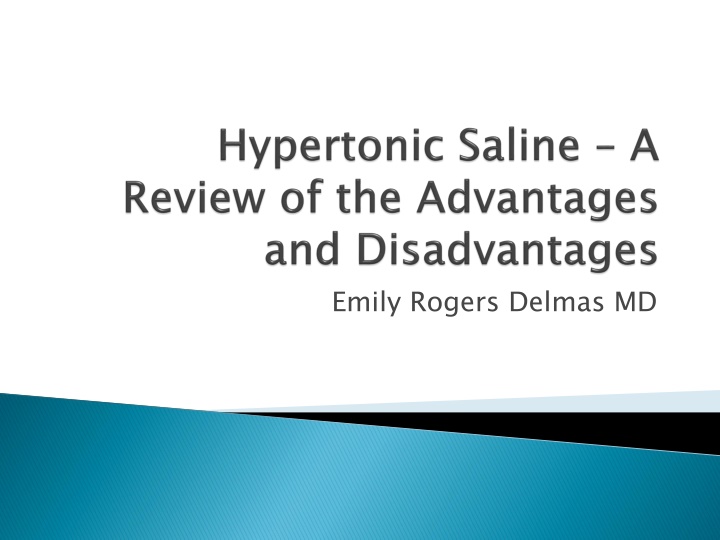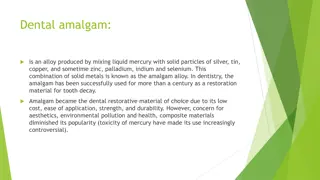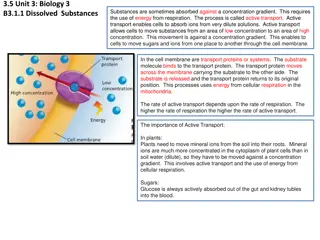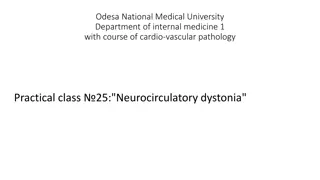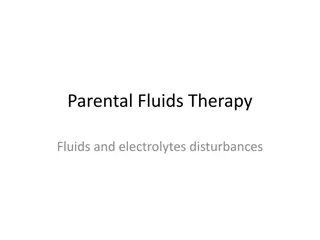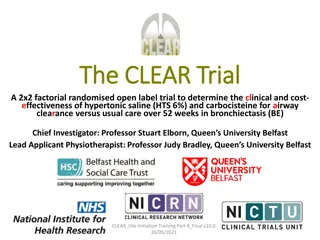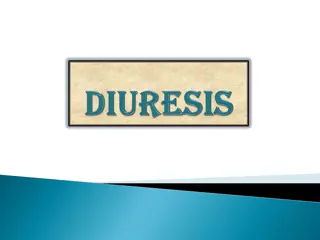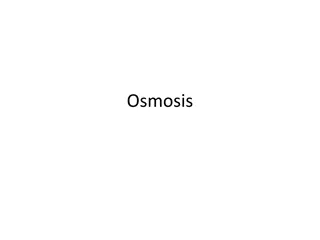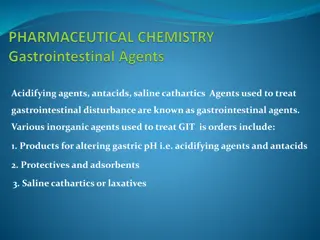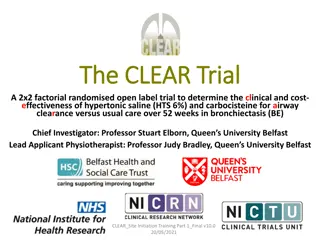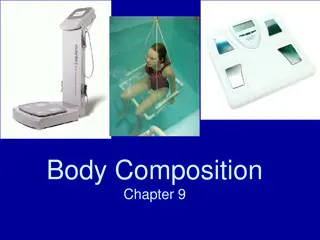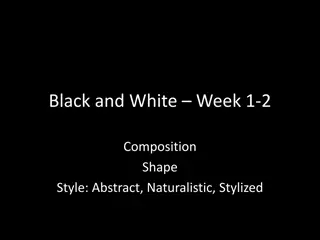Hypertonic Saline: Origins, Advantages, and Composition
Hypertonic saline, first used during the 1831 Blue Cholera Epidemic in Europe, has a rich history and physiological impact. This solution increases serum osmolarity, redistributing fluid to the intravascular space for volume repletion. Various formulations with different concentrations offer transient hemodynamic improvements and sustained volume expansion when combined with colloids. Studies have shown that hypertonic saline with dextran results in enhanced cardiac output and reduced total peripheral resistance. Learn more about the benefits and composition of hypertonic saline in medical practice.
Download Presentation

Please find below an Image/Link to download the presentation.
The content on the website is provided AS IS for your information and personal use only. It may not be sold, licensed, or shared on other websites without obtaining consent from the author.If you encounter any issues during the download, it is possible that the publisher has removed the file from their server.
You are allowed to download the files provided on this website for personal or commercial use, subject to the condition that they are used lawfully. All files are the property of their respective owners.
The content on the website is provided AS IS for your information and personal use only. It may not be sold, licensed, or shared on other websites without obtaining consent from the author.
E N D
Presentation Transcript
What is hypertonic saline? Origins Physiologic Response Advantages Disadvantages Evidence
1831 Blue Cholera Epidemic in Europe William Brooke O Shaughnessy published in The Lancet use of salted fluid in dogs with no harm Eventually adapted by physician Thomas Latta and used in patients with cholera with beneficial results
Multiple forms 2% 3% 7.5% 23.4%
Composition of Hypertonic Saline 0.9% = 154 mEq/L of Na and Cl 2% = 342 mEq/L of Na and Cl 3% = 513 mEq/L of Na and Cl 7% = 1200 mEq/L of Na and Cl 23.4% (bullet) = 4000 mEq/L of Na and Cl Many hypertonic saline formulations include a colloid dextran or hydroxyethyl starch
Increases serum osmolarity Causes redistribution of fluid from interstitial and intracellular space to the INTRAVASCULAR SPACE! And VIOLA! Repletion of intravascular volume
Transient hemodynamic improvement found with use of hypertonic saline alone Theory addition of colloid would selectively retain more water intravascularly
Hypertonic 7.5% Saline/6% Dextran 70 resulted in sustained higher cardiac output and MAPs Also resulted in lower total peripheral resistance compared to dextran or hypertonic saline alone Study completed with hetastarch as well and showed similar CV results, but less sustained volume expansion Smith GJ, Kramer GC, Perron PR, Nakayama S, Gunther RA, Holcroft JW. A comparison of several hypertonic solutions for resuscitation of bled sheep. J Surg Res. 1985;39:517 528. 528.
Hemodynamic Immunologic Infectious
Increase intravascular volume -> Restores MAPs Increase preload Increase cardiac output Decrease systemic vascular resistance Decrease afterload
Study looking at systolic and diastolic pressures in conscious hemorrhaged sheep Given 2 minute infusion of 200ml HSD MAPs increased after half of dose infused MAP normalized at end of infusion CO increased to 30% above baseline at end of infusion
Blunts neutrophil activation Decreases neutrophil-endothelium binding Reduces TNF alpha production Enhances function of normal T cells Restores function of suppressed T cells by stimulating IL-2
In vitro study added hypertonic saline in increasing concentrations to human peripheral blood mononuclear cells Measured the following: T cell proliferation -> increased IL-2 production -> increased Restored T cells Junger W et al. Hypertonic Saline Resuscitation: A Tool to Modulate Immune Function in Trauma Patients? Shock 1997:Vol 8 (4) 235-241.
Enhances intracellular killing of bacteria by attenuating receptor-mediated activation of pro-inflammatory cascades Limits inflammatory response
Retrospective study over 2 years, pair matched, case control study Looked at adult patients post-op back surgery admitted to SICU after major spinal procedure Matched for age, sex, operative site and magnitude, yr of operation Each pair one pt received hypertonic saline and one received isotonic fluid 57 pairs matched out of 364 patients Charalambous MP, Swoboda SM, Lipsett PA. Perioperative Hypertonic Saline May Reduce Postoperative Infections and Lower Mortality Rates. Surgical Infections. 2008; 9:67-74.
Infections HS group 3 Isotonic group - 11 Patients receiving HS in OR slightly longer Death HS group 2 (p = 0.19) Isotonic group 7 (p = 0.08) ICU LOS same (median time 22hrs) Hospital LOS HS 7.7 +/- 6.1 days Isotonic 7.3 +/- 3.5 days
Hypernatremia Hyperchloremic acidosis Potential for central pontine myelinosis Association with renal failure in burn patients Potential for extravasation injuries (tissue injury) 3% and higher must be infused via central access
UAB Compared burn patients resuscitated with either HS or LR Conclusions Pt resuscitated with HS had fourfold increase in renal failure Pt resuscitated with HS had 2x mortality of LR pts After 48 hours, cumulative fluid loads similar Huang PP et al. Hypertonic Sodium Resuscitation is Associated with Renal Failure and Death. Annals of Surgery. 1995; 221(5):543-554.
HS does not benefit neurologic function or mortality when compared with conventional fluids Effective at reducing ICP (3 RCT)
Trauma Randomized control trials 1.Bulger, E et al. 2008 (n=209), 7.5%/dextran vs. LR a) b) c) PRBCs did have decreased ARDS 2.Vassar M et al 1993 (n=233) a) b) c) Primary outcome = ARDS-free survival at 28 days Stopped early for futility Subset analysis in patients requiring > 10 units 4 arms= 7.5%, 7.5%/6%dextran, 7.5%/12%dextran, LR Higher increase in systolic BP with hypertonic saline All arms equal survival 1. Archive Surg. 2008; 143 (2):139-148. 2. Archive Surg. 1993; 128:1003-1013.
Critically-ill patients Meta-analysis: Burns, F et al. Cochrane Review 2008 14 trials with 956 patients Relative risk (RR) for death Trauma: 0.84 (95% confidence interval [CI] 0.69 to1.04) -> trend toward benefit Burns: 1.49 (95% CI 0.56 to 3.95) -> harm Surgery: 0.51 (95% CI 0.09 to 2.73) -> benefit
Peri-operative: favorable but not definitive Meta-analysis: McAlister V et al Cochrane 2010 15 studies, 614 patients Hypertonic saline benefits 1) Less volume received with equal diuresis -> less positive fluid balance 2) Increased maximum intra-operative cardiac index The truth awaits => not enough evidence on increased survival or organ function (small trials, not powered enough to detect outcome measures)
